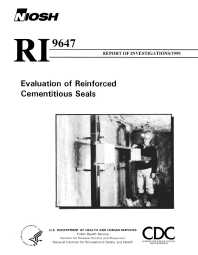Mining Publication: Evaluation of Reinforced Cementitious Seals
Original creation date: August 1999
The National Institute for Occupational Safety and Health (NIOSH), Pittsburgh Research Laboratory, cooperated with Tecrete Industries Pty. Ltd. and BHP Australia Coal in a research program to evaluate the strength characteristics and air leakage of four seal and two stopping designs for use in underground coal mines. A fundamental safety research area for NIOSH is to eliminate the occurrence of coal mine explosions or to mitigate their effects. One approach to achieve this goal is to develop new and innovative seal designs that provide increased explosion isolation protection for the mining personnel against ignitions that originate from within the gob or other worked-out areas of the mine. Full-scale seals and stoppings were constructed in the Experimental Mine at Lake Lynn Laboratory near Fairchance, Fayette County, PA. They were air-leakage tested, then subjected to a series of explosions with average pressure pulses ranging from 25 to 500 kPa (3.5 to 72 psi). Instrumentation measured seal displacement and acceleration as a function of time, providing data to assist in the development of numerical models for future seal design. All three seals designed with Meshblock wire formwork and a monolithic shotcrete core withstood the first explosion test, which generated an average maximum pressure of -140 kPa (-20 psi) while maintaining acceptable air leakage rates. These seals ranged from 175 to 325 mm thick. They included a 2.7-m-high by 325-mm-thick seal that was tested 27 hr after completion against this -140-kPa explosion pressure, a special requirement of the test program. This seal survived explosions with pressure pulses up to 300 kPa (43 psi). The 2.3-m-high by 325-mm-thick Meshblock seal survived three explosion tests with overpressures up to 455 kPa (66 psi) and satisfied the air leakage criteria. A 1,200-mm-thick plug seal was constructed of two Gunmesh formwork walls in-filled with shotcrete and a 3,450-kPa (500-psi) strength Aquablend core. This plug seal survived three explosions with pressure pulses ranging from 150 to 430 kPa (-22 to 62.5 psi) with no measurable post explosion air leakage. Two Gunmesh stoppings with thicknesses of 40 and 75 mm withstood explosion overpressures of 23 and 115 kPa, respectively. Anchoring all seal and stopping designs into the roof, ribs, and floor with steel "roofbolts" provided very effective boundary constraint that is critical to the performance of structures subject to explosion overpressures.
Authors: ES Weiss, KL Cashdollar, IV Mutton, DR Kohli, WA Slivensky
Report of Investigations - August 1999
NIOSHTIC2 Number: 20000251
Pittsburgh, PA: U.S. Department of Health and Human Services, Public Health Service, Centers for Disease Control and Prevention, National Institute for Occupational Safety and Health, DHHS(NIOSH) Publication No. 99-136, Report of Investigations 9647, 1999; Aug:1-42
See Also
- Compendium of Structural Testing Data for 20-psi Coal Mine Seals
- Designs for Rapid in Situ Sealing
- Designs for Rapid In-Situ Sealing
- Evaluation of Explosion-Resistant Seals, Stoppings, and Overcast for Ventilation Control in Underground Coal Mining
- Experimental Mine and Laboratory Dust Explosion Research at NIOSH
- Explosion Pressure Design Criteria for New Seals in U.S. Coal Mines
- Passive Mine Blast Attenuators Constructed of Rock Rubble for Protecting Ventilation Seals
- Progress Toward Improved Engineering of Seals and Sealed Areas of Coal Mines
- Structural Analysis and Design of Seals for Coal Mine Safety
- Use of Ground Penetrating Radar and Schmidt Hammer Tests to Determine the Structural Integrity of a Mine Seal
- Content source: National Institute for Occupational Safety and Health, Mining Program


 ShareCompartir
ShareCompartir
